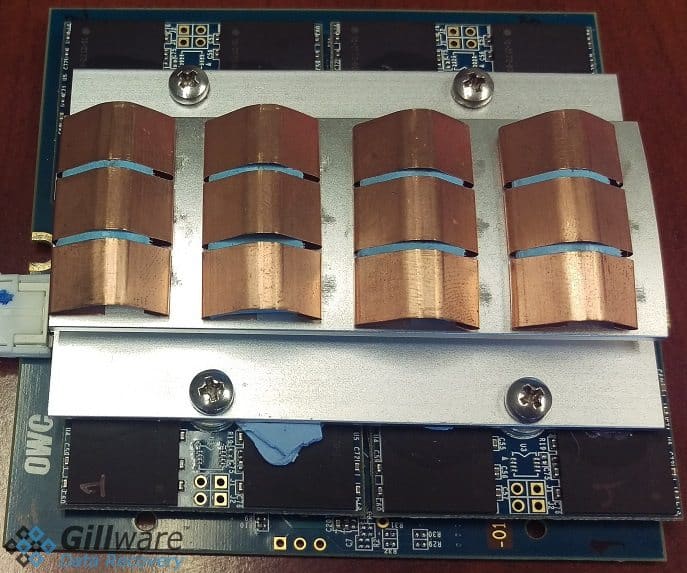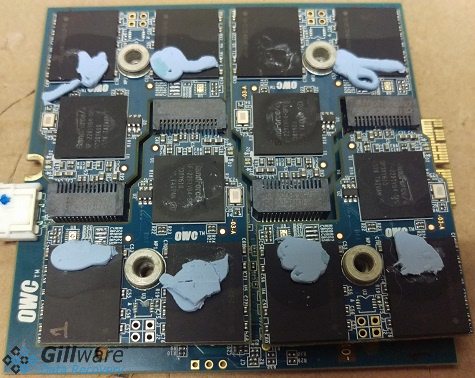OWC Aura SSD Data Recovery Case Study: Boot Failure
In this case, a client from a medical clinic came to us for our data recovery services. Using Parallels Desktop, they had been storing medical records on an OWC Aura SSD. The OWC Aura SSD was designed as a high-capacity replacement for the SSD used by default in Late 2013 Mac Pro computers. The client’s Aura offered two terabytes of storage space. Eventually, the Aura SSD failed and the client’s Mac Pro could no longer boot up. Without the ECW data on the computer, our client’s medical clinic was at a standstill. The client brought the drive to us for emergency OWC Aura SSD data recovery services.

OWC Aura SSD Data Recovery Case Study: Boot Failure
Drive Capacity: 2 TB
Model Number: OWCSSDA13MP2.0K
Operating System: Mac
Situation: Won’t Boot
Type of Data Recovered: Medical clinic ECW data on Parallels VMs
Binary Read: 99.9%
Gillware Data Recovery Case Rating: 9
What’s Inside an OWC Aura SSD?

OWC’s Aura was made for users of late 2013 Mac Pro computer models. The drive used the same PCIe 2.0 interface as the internal SSD contained in the computer by default. This made it easy to swap the drives. The Aura came in several sizes, ranging from 1 to 4 terabytes. This gave it between roughly four and sixteen times the 256 GB capacity of the original factory drive.
Our SSD engineers were eager to take apart this solid state drive. When they removed the heatsink, they found that this OWC Aura was more complicated than your average SSD. The OWC Aura SSD wasn’t just a high-capacity SSD. It was, in fact, four SSDs. An SSD isn’t just one chip—it’s several NAND memory chips, connected and managed by a controller chip. Each SSD had two NAND chips and its own Sandforce SSD controller. The four SSDs, with a total of eight NAND chips between them, combined to make up a single logical volume. Our data recovery technicians found that this SSD was, in fact, a RAID-0.
Challenges in OWC Aura SSD Data Recovery
RAID-0 is a way of combining separate storage devices to appear as a single volume. RAID-0 does this by breaking everything up into stripes. Each stripe is usually 64 kilobytes wide. If even a single device fails in a RAID-0 setup, the whole thing goes down. If the RAID controller fails, the whole thing goes down. Because of this, RAID-0 arrays have many, many more failure points than single data storage devices. In this OWC Aura SSD data recovery case, there was no telling until our engineers cracked open the device which failure point had caused it to fail.
The device had a complex and proprietary design that made this OWC Aura SSD data recovery case a long shot. Each SSD was connected to a single circuit board and linked to another controller. This controller handled the RAID striping. We had our fingers crossed that the RAID controller was the point of failure. Due to AES encryption, if any of the SSD controllers had died, its assigned SSD would have gone with it. Self-encrypting SSDs are devilishly hard to recover data from with manufacturer assistance, and impossible without.
Our client’s hope for a successful recovery depended on our engineers’ abilities to recover every SSD in this device. Due to the data striping, if we couldn’t resuscitate even just one SSD, the results would be catastrophic. Any file large enough to fit across four or more stripes would have at least one hole in it. On average, one out of every four files smaller than the stripe size would vanish. And around one-fourth of the Aura SSD’s file definitions would be missing as well.
The OWC Aura SSD Data Recovery Process and Results
First, our SSD recovery experts removed each SSD from the Aura SSD device. A nonstandard interface connected them to the RAID controller board. But once we had access to each SSD, we were able to create full forensic images of them. The next step in the OWC Aura SSD data recovery process was to take each image and link them together. Our RAID recovery experts would have to write custom software to emulate the RAID controller’s functions. This would give us full access to everything we’d recovered. Finally, the last step was to go into the client’s Parallels Desktop virtual environment and make sure their critical data worked.
After all our engineers’ hard work, this OWC Aura SSD data recovery case proved to be successful. Our engineers were able to recover the client’s medical clinic ECW data from their Parallels desktop. We then tested the most critical files to make sure they functioned properly. Then we sent their data back to them on a password-protected hard drive to keep their data secure. While this OWC Aura SSD was a highly unusual device, our data recovery engineers were able to recover the client’s data and get it back to them in a timely fashion. Our engineers rated this OWC Aura SSD data recovery case a 9 on our ten-point scale.
